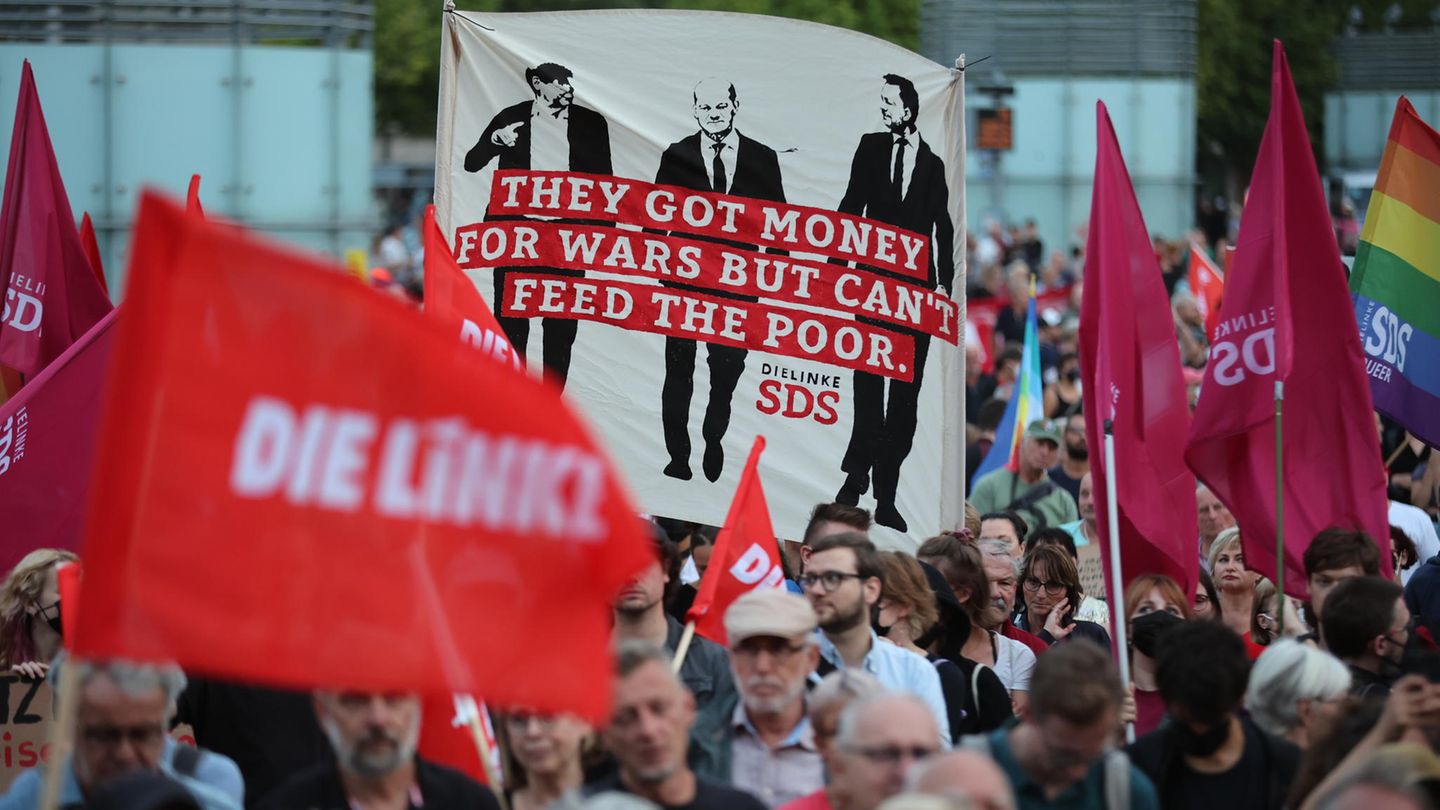analysis
In the “hot autumn” left and right are mobilizing against the social coldness. On the street, they criticize the federal government with sharp words. But how big is the intersection between the two groups really?
A Monday on Augustusplatz in Leipzig. Thousands have gathered under the keyword “hot autumn” to express their dissatisfaction with the energy and social policy of the traffic light government. Posters with the likenesses of Habeck, Scholz and Lindner float through the air, equipped with slogans such as “Der Kaltmacher” (meaning the Minister of Economics) or “You have money for wars, but cannot feed the poor”. It is not an ordinary Monday demo, as the Federal Republic has known since the corona pandemic from conservatives and right-wingers in East Germany.
Because on the Augustusplatz in Leipzig not only supporters of the right-wing party “Freie Sachsen” gathered this September. The left – the member of parliament Sören Pellmann even spoke of a Monday demonstration – called for a protest and was able to gather a corresponding crowd. The fact that the left are now showing up next to the right has “a funny note” for AfD boss Timo Chrupalla. For the left, on the other hand, it is clear: they don’t want “the right to take a day of the week away from them”.
This may be the beginning of the “Winter of Anger” predicted by social researchers and feared by politicians. A wave of social protests fueled by the energy crisis, inflation and exploding costs. Separated by the police, site fences and basic political ideologies, two groups position themselves side by side and yet together against the policy of the traffic light government. Does this “hot autumn” end with the confession that left and right are closer than the political spectrum suggests – and that the parties want to admit to themselves?
Left and AfD jointly criticize the federal government
At least that would correspond to the horseshoe theory, according to which two extremes will eventually collide again. However, political scientists disagree. “Left and right are both mobilizing on the street against the federal government, but that’s it again with the essential similarities,” said Uwe Jun, political scientist at the University of Trier in an interview with the star clear. And Torsten Oppelland, political scientist at the University of Jena, makes it clear that the ideological patterns of both parties are too different.
But what makes things tricky: “In day-to-day politics, these differences hardly come into play.” A look at the demonstration in Leipzig is enough for that. At the request of star Left and AfD wrote down their positions and their criticism once again – with numerous overlaps in content. Both parties blame the current federal government, but also political decisions of previous governments, for the current price increases. Both think fuel prices are way too high and need to be reduced. The same applies to food prices. Both parties consider the third relief package to be insufficient. In addition, both reject the arms deliveries to Ukraine – which should speak for a critical attitude towards the USA and a Putin-friendliness.
At least that corresponds to the experiences of political scientist Oppelland. He compared speeches and voting behavior of right-wing and left-wing MEPs in the European Parliament. The result: Both groups share their rejection of the US and their positive attitude towards Vladimir Putin. This can also be seen now that the AfD strictly rejects the Russia sanctions – as does part of the left. However, the moderate part of the party advocates “sanctions aimed at Putin’s power apparatus, at the oligarchs and at the Russian war industry,” faction leader Amira Mohamed Ali clarifies.
Who really stands for social justice
Despite the common points of criticism and Monday demonstrations, the AfD and the Left Party cannot currently govern together, as the right-wing and left-wing populists did in Italy a while ago, says political scientist Jun. “The differences on the cultural lines of conflict are far too great for that.” While the Left programmatically clearly demands an identity policy for social minority groups and speaks out against any form of exclusion towards them, this point of view is met with rejection by the AfD. This in turn favors values such as nationalism and traditional ways of life. According to Jun, it is also unclear how the AfD positions itself on social issues. “While the radical wing is more in favor of the welfare state, the more moderate part tends towards market solutions,” explains Jun.
Social justice is not a main motive for the right in Germany, say the political scientists. The aim of the protests is to mobilize against the policies of the federal government and to make it clear that they do not agree with it,” says Jun. The party program also does not indicate that social equality is a key motive of the party. Unlike the left: “The desire for social equality”.
Different views on solving the energy crisis
The solutions with which the parties would counter the current problems also show that there would be a lot of crunching in a coalition of AfD and Left. As is well known, the AfD thinks little of the climate change and would instead reactivate decommissioned nuclear power plants, have new nuclear power plants built and put the Nord Stream 2 gas pipeline into operation. “A forward-looking policy would not have promoted the phase-out of nuclear power and coal against all energy-political reason. This is unique in the world and must now be paid for by the citizens and the economy,” criticizes AfD co-head Alice Weidel. The left, on the other hand, is demanding a program from the federal government, comparable to the special fund for the Bundeswehr, for the expansion of renewable energies.
The third relief package would also be put together differently by the two parties. Weidel sees this only as “combatting the symptoms”, she describes one-off payments as costly redistribution measures, and further government spending would not stop inflation. The left, on the other hand, is demanding higher direct payments, an excess profit tax, an energy price cap and the end of the gas levy.
“There will be no fraternization”
Even if the left does not flirt with the right – the offer from the Free Saxons to demonstrate together was rejected – the demonstrations could become a problem for the left alongside the right. Because the demarcation is not very clear in view of the common points of criticism.
Nevertheless: “The left has a number of central dogmas that are sacred to their party ideology. Anti-fascism is the highest of all. There will therefore be no fraternization,” says Oppelland. And AfD boss Chrupalla also makes it clear that demonstrations by other groups will not be joined. “We don’t need to take to the streets with the left or with the Free Saxons.” This means that the right and left will probably continue to stand next to each other on Augustusplatz – and demonstrate separately for the same cause.
Source: Stern
David William is a talented author who has made a name for himself in the world of writing. He is a professional author who writes on a wide range of topics, from general interest to opinion news. David is currently working as a writer at 24 hours worlds where he brings his unique perspective and in-depth research to his articles, making them both informative and engaging.




